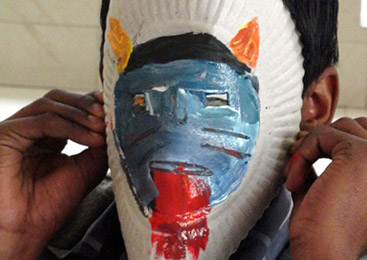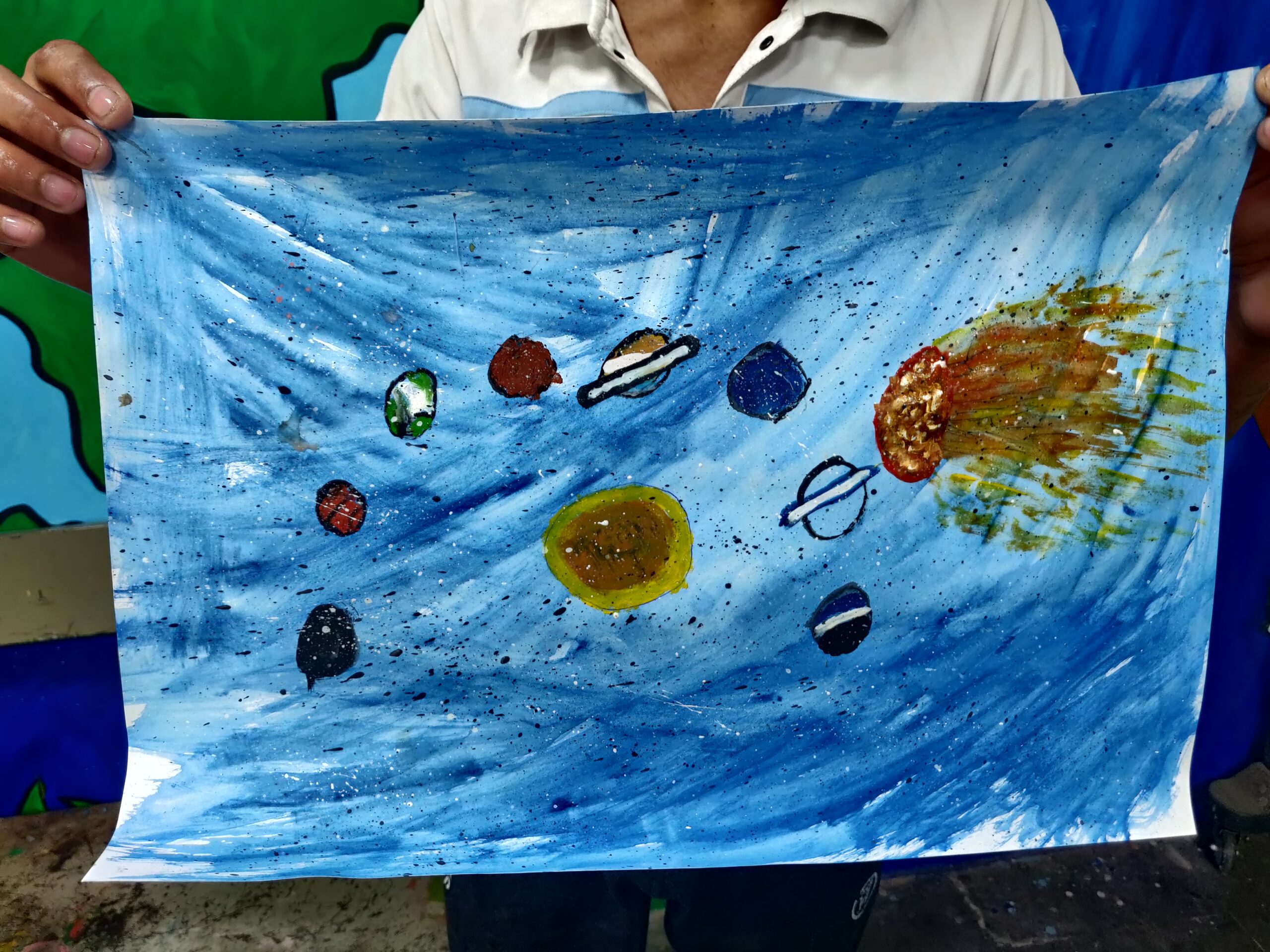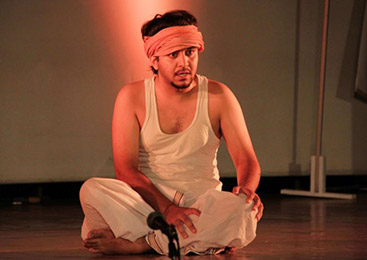In their minds, Through their eyes!
02-Dec-2018When I first met Veeru ( name changed) at the de-addiction centre for juvenile delinquents in Sewa Kutir- SPYM Sahyog, I was struck by his concentration level and his love for colours. Thoroughly enjoying the vibrancy of colours while painting match boxes, he started telling me about his family and lifestyle. Veeru’s father was an alcoholic and he passed away when he was very young. His mother got married to someone else and left him. “I was in dire need of money. Hence I had to do what I did”, says Veeru. The need for survival is the biggest need that drives any species. Faced with a choice between survival and landing up in the delinquent centre, what else could a fifteen year old Veeru have done? Eighteen year old Nawas ( name changed) has a happy family of mother, father and siblings at home. He was studying in class ten before coming to the centre and his mother wanted him to be a lawyer. “My friends told me it was cigarette. I did not know what was inside the roll. When I started enjoying it, I needed more of it”, says Nawas. Psychologists suggest that late teens are an age when there are extensive hormonal changes in boys and girls. There is a need for thrill and excitement. Such is the age when the activities of the peer group always appeal more than those of elders or other family members. When this peer pressure leads to drug abuse, there begins a vicious cycle. Drug consumption leads to a need for more drugs and this leads to illegal activities to obtain the means to get more drugs. In the process, the teenager might end up selling drugs to other teenagers. Kamal ( name changed) is eighteen years old and he lives with parents too. Enthusiastic and full of life, he aspires to work very hard once he goes out. “My girlfriend had left me. Drugs gave me a lot of comfort”, says Kamal. We live in a society and culture where there is an obsession with finding ‘love’. The movies we watch, the songs we listen to and the books we read, all seem to reinforce this belief in a need for a partner. The need becomes all the more strong when we see our friends indulging in ‘love’. In such a situation, when a relationship fails, there is almost a sense of guilt and shame and also an urgency to prove one’s heroism. If not a relationship, then perhaps there are other ways to fit in to the peer group. The dazzling eyes of twelve year old Raam(name changed) had caught my attention the very first day that I had stepped into the centre. His agility and chirpiness had literally won my heart. Experimentation, peer pressure, these are traits associated with boys and girls in their mid teens. What could have led a boy who has not even stepped into his teens to substance abuse? It is possible that we are exposing our kids to too much television and media influence. Research suggests that children are most prone to being affected by what they see on the television screen. It is also possible that there is an excessive companionship and dependency on older boys in the peer group who become role models for the younger ones. Delinquency is not just a social problem; it is the root of a much bigger social problem. Sigmund Freud’s psychoanalytic theory suggests that an individual’s personality is mostly established at the stage of early childhood. Early experiences have a large role to play in the development of personality and continue to affect the individual’s behaviour in later years. It is essential that children go through a healthy development during the early years of their lives. The rise in energy levels that takes place during the adolescent years should be directed towards productive activities. Keeping them engaged in art, music, dance, drama, sports and so on, gives them a proper outlet for the aggression within, as well as helps in their personality development. Furthermore, this aggression needs to be kept in control through parental check and disciplinary measures. Most importantly, children need to be given an ‘I can make a difference’ boost. If they are constantly reminded that their actions will make a difference to society then they will be more prone to indulge in activities which are beneficial to them. However, the biggest problem arises when children do not have the means to ensure that the above mentioned suggestions are enforced. Poverty or absence of parents and teachers as role models is the bigger problems that lead to delinquency since they are extremely difficult to solve. In such a situation, it is imperative that the state and society steps in to ensure that the children are not left to rot. After all, the kids are the responsibility of the society as a whole and their actions will affect the society as a whole too. It is our responsibility to make sure that every Veeru, Nawas, Kamal or Raam grows up to be an ideal role model for generations to come. – Adrija Roychowdhury is a Masters student studying History from Delhi University. With a keen interest in theatre, adventure and human stories; she aspires to become a journalist in the future. She is currently, also volunteering at the Foundation to write about different narratives of human motivation, social justice and human rights.
MORE ARTICLE FROM OUR BLOG

Volunteer’s Diary- Sahyog
Entering the gates of Sahyog campus triggered a series of emotions in me. Was it anxiety or fear or anger or compassion or curiosity? I don’t know! I entered the campus with an empty mind. I tried not to have any presumed notions about these juvenile offenders. The term ‘juvenile’ is used for person below the age of 18, accused in any crime. Having worked with children before, I believe these children were a little different. However, they were and they did behave like any other child of their age group would have.
Freud’s Psychoanalytic theory suggests that personality is mostly established by the age of five. Early experiences play a large role in personality development and continue to influence behaviour later in life. If these psychosexual stages are completed successfully, the result is a healthy personality. If certain issues are not resolved at the appropriate stage, fixation can occur. Perhaps, this issue makes them different from other children. Dysfunctional family, certain incidents, addiction, poverty, illiteracy, lack of guidance affects them.
Consequently, I was there to grasp and learn all I could, therefore I did not want to talk or do anything. I did not want to interrupt their activities. I just wanted to observe. Observe their actions, reactions.
I was amazed to learn how they had perceived of me as their ‘female’ volunteer, my clothes and my gestures. I was shot at with vulgar comments momentarily. They excelled at playing and twisting my words, so as to change its meaning completely. To their surprise, I was good at dodging them. With my presence, I was determined to bridge the gap. Their constant gaze at me confirmed the urgency of the same. We shook hands, talked, and laughed.
We started with the workshop, with over 30 boys. We worked on painting and decorating matchboxes.
I was happy to see the positive reaction towards the workshop. I took as a sign of acceptance. There were moments of vexation. However, my aim was to read into their minds, rather than sit back out of disappointment. Matchbox was just a medium. Whether they painted it or not, didn’t really matter. Small dusty hands, with chewed nails, scribbling black and white stripes, and then painted it all black, when almost a beautiful unpredictable design was going to come out. Some chose to keep quiet and observe, while some found it impossible to be quiet. I was amused to overhear a myriad of comments.
It was perhaps because of lack of interaction with the other sex. Their curiosity about the other sex is incomplete. Coming from dysfunctional families, the very idea of one’s mother, sister or a friend was still hazy. Most of them come from backgrounds where a casual friendly relation with the opposite sex is stigmatized. There was a tendency in them to emulate all ”film stars” and bollywood actors.
Bruise and cuts on their wrists and arms were enough for me to understand their extent of extreme feelings.
With my presence, I hope to abridge the gap between ‘us’ and ‘them’. They are disheartened and some have lost hope of coming back on track. I don’t want to be an idealist to them, but just wish to expose them to the normalcy of life, be it towards women, elders or law. Their expression in the form of art can be our path into their minds.
– Sanya is a Masters student who has been volunteering with us for a month. This is her feedback from her first session at SPYM Sahyog de addcition home.
READ MORE
Colours of Hope!
The workshop that me and Poorva had thought of did not have a structure. It stemmed from a simple idea: no structure, just boys, paper, and the freedom to let the brush guide them. The world that the boys live in is already structured and bound by rigid rules. Adding more structure would just mimic their daily routine. Imagination is limitless but while talking to the volunteers at the home I realized that imagination can be limited if one is never allowed to explore and think beyond one’s boundaries.
While talking to Puneeta there was a discussion on people who come from outside for workshops can be a sign of hope for the boys. I do not know how I can be a sign of hope at times because I struggle in my daily life to find hope in terms of my future, but maybe because I do not have any literal constraints such as the bars that surround the boys but only the constraints in my mind. Maybe because I can see the sky without any physical/material constraints and can draw the Sonipat skies without having to emphasize the jail bars in my painting. Maybe because for me freedom is easy and taken for granted.
When we started to distribute brushes and paint there was a sense of confusion as the boys had to make their own choice in selecting the brushes like they didn’t know what and how to choose. When we began to paint few of them just sat down and looked at the empty canvas and other the room to search for an inspiration or idea. Some were skeptical to even pick up the brush and start using watercolors because it was new, and no colors appealed to them. Black dominated the palettes of five or six boys. It resonated with me. Why black? What darkness did they find in that shade? Did it grant them the courage to explore other colors, or perhaps express the darkness within them? There I was, surrounded by black, starting my own piece with vibrant reds, pinks, and greens. Paradoxical? Two realities coexist. But slowly, their paintings transitioned from darker shades to a lot of blue, sceneries, and smiley faces in inanimate objects.
I don’t know if the workshop will be fruitful in the long run, but I do hope that their imaginations will not be bounded by constraints of the society and boys will be shackled by the darkness of their past. Like any other teenager, I can only wish for them to find their happiness in the realm of their imaginations if not anything else.
– Eshani Bora, Young India Fellow, Ashoka University
READ MORE
Sweet Reminiscence
What does it take to not forget something? Has it ever happened to you, that when you return from somewhere you have a difficult time adjusting at home? Withdrawal symptoms (as close as it could get) a plenty and you keep asking for more of the same experience. The only thing you think about for sometime is when, where and how you will get an opportunity to go back to the same place and experience something completely new? The true meaning of the term unforgettable is learnt. When you narrate stories of your journey, your mind leaves you gasping for more. Nostalgia, happiness, a weird feeling in the stomach, everything that makes you believe that this journey was special.
I don’t exactly remember when the process started and I certainly know it hasn’t ended. Once upon a time when we only thought we would be in Glasgow one day is now a time, existing, flowing, real and lived. We weren’t tourists (only), our intent was clear. That one hour in which we get to perform our play made the trip of ten days possible. ‘Shoonya se shikhar tak’ is therefore a landmark in my life. The intense training, workshops and preparations for this production has been growing experience. As an actor and as an individual, I have unmasked a lot within me. Shoonya se shikhar tak has not only made me realise the power of my dreams, but also my abilities to work on them. I can proudly say this intensity has made me lighter and stronger at the same time. The magical part is that i dont even know when this process started. It just seems smooth now that I look back on all these memories with fondness.
All of this however wasn’t limited to the one hour in the rotunda. But I think that this growth took a different course from there. Now that I think about it, I can’t find any words to describe my feelings the first time I stepped on the cushioned stage of the rotunda. The first time I ever tested my voice inside that dome, the first time I walked, crossed from one side to the other. Each movement of my body made me want to get that emotion more and more and made me never want to end this experience. And that one hour, when all our rehearsal time, our practise came to its actual test, the hour that made it all possible was an hour that I want to keep reliving. That one hour in which I was vulnerable, both emotionally and physically, on stage and especially off it is the hour I crave. As if that’s the kind of reality I want to keep living. Shoonya se shikhar tak has reached its first shikhar. I think it is time we take it forward, continue to work with ourselves and with this experience and make this journey limitless.
Its not so much about living a dream. It doesn’t hit you always that what you thought of once upon a time, is a reality you’re living. Its after you’re back, trying to adjust with your life that you realise that you just lived what you yearned for. I want to live it again. And keep living it.
For all this and more I would like to extend my heartfelt gratitude to everyone concerned and everyone who made this possible.
“Mere sapnon ka Yeh andaaz hai, ki har rang mein shaksiyat kuch khaas hai.
Mai kehta hoon Bohot ji li zindagi, Woh kehta ki abhi aur Jine ke aas hai.”
– Rijul Kataria works as a Research Coordinator with the Foundation. This blog was written as a part of the Tin Forest International Theatre Festival in 2014
READ MORE




